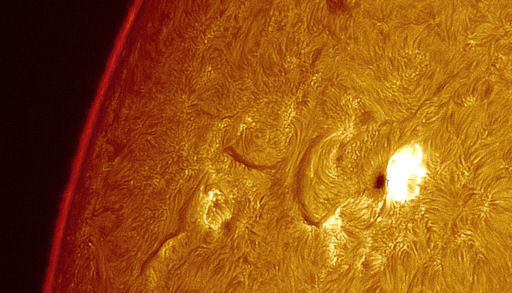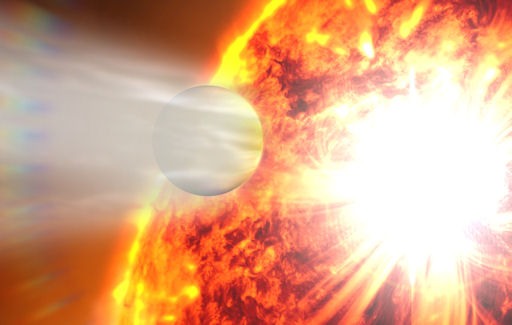HIDDEN PORTALS IN EARTH'S MAGNETIC FIELD: A NASA-sponsored researcher at the University of Iowa has developed a way for spacecraft to hunt down hidden magnetic portals in the vicinity of Earth. These gateways link the magnetic field of our planet to that of the sun, setting the tage for stormy space weather. [video]
CHANCE OF FLARES: NOAA forecasters estimate a 30% chance of M-class solar flares today. The likely source would be either sunspot AR1512 or AR1513. Both have 'beta-gamma' magnetic fields that harbor energy for strong flares.
Yesterday in Bispingen, Germany, amateur astronomer Cai-Uso Wohler was monitoring the sun when AR1513 erupted:
The impulsive M2-class solar flare illuminated Earth's upper atmosphere with a pulse of X-rays and extreme ultraviolet radiation. This, in turn, created a wave of ionization over Europe, which altered the propagation of low-frequency radio transmissions around the continent. Using a receiver tuned to 23 kHz, Dave Gradwell detected the disturbance over Ireland. More ionization waves are in the offing as AR1512 and AR1513 crackle with flares. Stay tuned. X-flare alerts: text, voice.
Realtime Space Weather Photo Gallery
X THREE MILLION: On the Richter Scale of Solar Flares, X3 is considered to be a big explosion. How about X3 million? NASA's Hubble Space Telescope has seen what happens when a planet gets hit by such a flare. This artist's concept, released today by the space agency, illustrates the impact of an X3000000-class stellar flare on exoplanet HD 189733b:
The flare, detected by NASA's Swift satellite, scorched the top of the planet's atmosphere with a powerful blast of ultraviolet radiation and X-rays. Hours later, Hubble detected more than 1,000 tons of gas every second flying away at 300,000 mph. HD 189733b is a gas giant about 14% more massive than Jupiter, so it hardly misses the atmosphere it lost. Millions of years of these flares, however, will eventually make a dent even in such a massive world. So the next time there's an X-flare here in the solar system, just remember, it could be worse.

![]()
Solar wind
speed: 371.7 km/sec
density: 2.7 protons/cm3
explanation | more data
Updated: Today at 1436 UT
![]()
X-ray Solar Flares
6-hr max: M2 0920 UT Jun29
24-hr: M2 0920 UT Jun29
explanation | more data
Updated: Today at: 1400 UT
![]()
![]()
![]()
Daily Sun: 29 Jun 12
![]()
![]()
Sunspots 1512 and 1513 pose a threat for M-class solar flares. Credit: SDO/HMI
![]()
![]()
![]()
Sunspot number: 73
What is the sunspot number?
Updated 29 Jun 2012
Spotless Days
Current Stretch: 0 days
2012 total: 0 days (0%)
2011 total: 2 days (<1%)
2010 total: 51 days (14%)
2009 total: 260 days (71%)
Since 2004: 821 days
Typical Solar Min: 486 days
Updated 29 Jun 2012
The Radio Sun
10.7 cm flux: 120 sfu
explanation | more data
Updated 29 Jun 2012
![]()
![]()
![]()
Current Auroral Oval:
![]()
Switch to: Europe, USA, New Zealand, Antarctica
Credit: NOAA/POES
![]()
![]()
![]()
Planetary K-index
Now: Kp= 1 quiet
24-hr max: Kp= 1 quiet
explanation | more data
![]()
Interplanetary Mag. Field
Btotal: 5.6 nT
Bz: 1.1 nT south
explanation | more data
Updated: Today at 1436 UT
![]()
![]()
![]()
Coronal Holes: 29 Jun 12
![]()
![]()
Solar wind flowing from this coronal hole should reach Earth on July 2-3. Credit: SDO/AIA.






